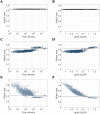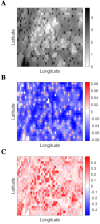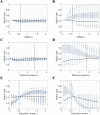Differential mobility and local variation in infection attack rate
- PMID: 30668575
- PMCID: PMC6358099
- DOI: 10.1371/journal.pcbi.1006600
Differential mobility and local variation in infection attack rate
Abstract
Infectious disease transmission is an inherently spatial process in which a host's home location and their social mixing patterns are important, with the mixing of infectious individuals often different to that of susceptible individuals. Although incidence data for humans have traditionally been aggregated into low-resolution data sets, modern representative surveillance systems such as electronic hospital records generate high volume case data with precise home locations. Here, we use a gridded spatial transmission model of arbitrary resolution to investigate the theoretical relationship between population density, differential population movement and local variability in incidence. We show analytically that a uniform local attack rate is typically only possible for individual pixels in the grid if susceptible and infectious individuals move in the same way. Using a population in Guangdong, China, for which a robust quantitative description of movement is available (a travel kernel), and a natural history consistent with pandemic influenza; we show that local cumulative incidence is positively correlated with population density when susceptible individuals are more connected in space than infectious individuals. Conversely, under the less intuitively likely scenario, when infectious individuals are more connected, local cumulative incidence is negatively correlated with population density. The strength and direction of correlation changes sign for other kernel parameter values. We show that simulation models in which it is assumed implicitly that only infectious individuals move are assuming a slightly unusual specific correlation between population density and attack rate. However, we also show that this potential structural bias can be corrected by using the appropriate non-isotropic kernel that maps infectious-only code onto the isotropic dual-mobility kernel. These results describe a precise relationship between the spatio-social mixing of infectious and susceptible individuals and local variability in attack rates. More generally, these results suggest a genuine risk that mechanistic models of high-resolution attack rate data may reach spurious conclusions if the precise implications of spatial force-of-infection assumptions are not first fully characterized, prior to models being fit to data.
Conflict of interest statement
The authors have declared that no competing interests exist.
Figures






References
-
- Sutton P, Elvidge C, Obremski T. Building and Evaluating Models to Estimate Ambient Population Denstiy. Photogrammetric Engineering and Remote Sensing. 2003;69(5):545–553. 10.14358/PERS.69.5.545 - DOI
Publication types
MeSH terms
Grants and funding
LinkOut - more resources
Full Text Sources
Other Literature Sources

